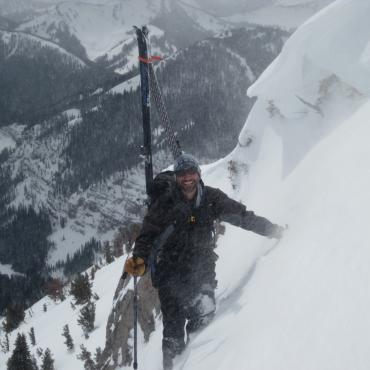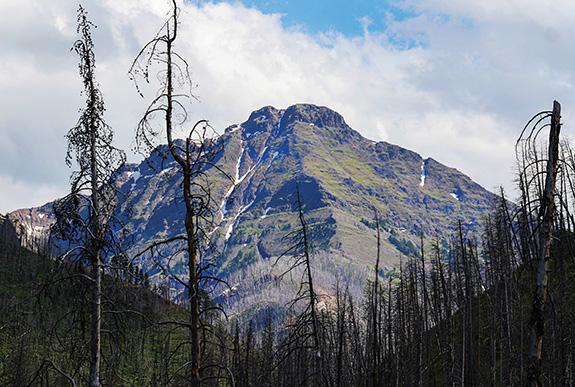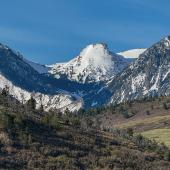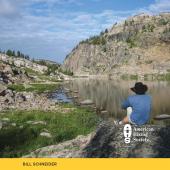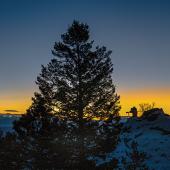Up a Creek in Paradise
Climbing Mount Wallace.
“So, if you cannot understand that there is something in a man which responds to the challenge of the mountain and goes out to meet it, that the struggle is the struggle of life itself upward and forever upward, then you won’t see why we go. What we get from this adventure is just sheer joy. And joy is, after all, the end of life. We do not live to eat and to make money. We eat and make money to be able to enjoy life. That is what life means and what life is for.” —George Mallory, 1922
Driving south on Hwy. 89 in Paradise Valley, travelers are treated to nearly an hour of spectacular views of the western front of the Beartooths. This steep mountain wall yields little information about what lies deeper within the range. However, about six miles north of Emigrant, a vista opens into Mill Creek, the only major break that pierces the Western Beartooth front. Framed between steep ridges at the canyon’s gates and dominating the distant skyline at the canyon’s head is a striking pylon of rock known as Mount Wallace. Merely the fifth highest peak along the arc of volcanic peaks dominated by the Pyramid, and one of only three named peaks along that chain, Mount Wallace achieves prestige by its sheer beauty and eminence when viewed from that one perspective in Paradise Valley.
The image of Mount Wallace framed by the walls of Mill Creek is so noteworthy that in 1925 the Forest Service named it for Iowa-born Henry Cantwell Wallace, who served as Secretary of Agriculture under President Warren Harding from 1921 until his death in office on October 25, 1924. The name appeared on the 1930 Absaroka National Forest map and again on a 1934 edition of the 60-minute Livingston quadrangle. The U.S.G.S. maintained the name “Mount Wallace,” not only on the summit, but also as the titles of both the 15-minute Mount Wallace quadrangle, published in 1966, as well as recent versions of the 7.5-minute quadrangle containing both summits.
The first recorded ascent of Mount Wallace was made in 1936 or ’37 by U.S.G.S. topographers John L. Lewis, F. H. Purdy, L. K. Peterson, and C. P. Van Camp. Throughout the early 1950s, a series of surveyors revisited this prominent summit to fine-tune horizontal control in the region. Among these was Ector Brooks Latham, who spent the 1950 survey season climbing some 20 major mountains in northern Greater Yellowstone for triangulation purposes. In addition to Mount Wallace, Latham visited Trout, Indian, Cooke, and Avalanche peaks in the Northern Absaroka; Younts Peak, Overlook Mountain, Mount Sheridan, Gravel Mountain, and Breccia Peak in the Southwest Absaroka; Electric Peak in the Gallatin Range; Emigrant Peak, Tumble Mountain, Black Mountain, Monument Peak (in 1955), and Livingston Peak in the Beartooths; Mount Washburn; and Heart Mountain.
Ector B. Latham was born on November 23, 1900, in Rockton, South Carolina. He graduated from the University of Maryland with a degree in civil engineering in June 1924. The following year, he began a 32-year career with the National Oceanic and Atmospheric Administration, first as a ship officer, then as a hydrographic surveyor for the War Department during World War II, and later as a geographic surveyor in the mountain states. While his exemplary performance under enemy fire in New Guinea won him several honors, his season of surveying in Greater Yellowstone left him with some of his fondest memories. A love for mountains ran in his family as his father, who was also named Ector B. Latham, participated in the first expedition into the Mount St. Elias region. Latham junior has been described as “a big John Wayne sort of fellow, primarily a field man and not the greatest of politicians… tough, inventive, competent, knowledgeable, and willing to tell it like it is.”
Ascent
To approach Mount Wallace, drive 12 miles up Mill Creek Rd. and park at Wallace Creek trailhead. Hike for 2.5 miles along Passage Creek and take the left fork after Passage Falls. From here, a fantastic view of the north side of Mount Wallace is revealed, although suddenly spoiled when you arrive at a small village of private homes and ranches. Bypass the private land on the east canyon flank, and then bear left at a junction into Wallace Creek. Follow the excellent Wallace Creek trail for five miles to the saddle southwest of the summit. Walk the broad, gentle, and scenic southwest ridge for 900 vertical feet to the top.
While most ascents of Mount Wallace are made by its non-technical southwest ridge, Jack Tackle climbed the remarkable north couloir in winter during the 1980s. It rises over 2,000 feet out of the head of Wallace Creek directly to the summit. About halfway up, it narrows and steepens to about 50 degrees. On May 28, 2003, this author and Jamie Weeks skied and snowboarded this circuitous slot-canyon-like route in wet-powder conditions. On another occasion, Tackle ski-traversed the South Snowy Block from Mill Creek to Tower Junction via the pass just southwest of Mount Wallace.
Details
Mount Wallace Summit: 10,697 feet
Wallace Creek parking elevation: 6,315 feet
Elevation gain: 4,382 feet
Distance: 10 miles
Overall grade by southwest ridge: II Class 1
Estimated ascent time: 4 to 7 hours
Maps: Knowles Peak, The Pyramid, Mount Wallace
This is an excerpt from Select Peaks of Greater Yellowstone: A Mountaineering History and Guide, published in 2003 by Thomas Turiano. Turiano is currently working on the long-awaited revision of Select Peaks from his home in Wilson, Wyoming. Order your copies and subscribe to book updates at selectpeaks.com.

